Day 5 Part 1 September 1 Trip to Qena, meet the Nile and Dendera Temple
I was SO glad I had not signed up for the balloon ride, because the ballooners had to be up at 4:15 and off by 4:45 so that they could balloon to the sunrise. Spousal Unit D and I however got to luxuriate in bed and take it easy. Unfortunately I slept through all those balloons rising over the Valley of the Kings, but I really needed to sleep in. We got to eat a leisurely breakfast and then when the ballooners got back around 8 AM we set sail for Qena north of Luxor. This was the first time the ship had moved since we had been on it. It was such a gentle, soothing motion. I took the morning time to explore the ship.
It had three basic floors plus a basement area where the restaurant was located. D. and I were on the middle floor above the ground level floor depicted above. There was a sun area on top, with a tiny pool and lots of deck chairs and a bar. It was a lovely comfortable place to hang out (if we had had any other time to do so.)
You also got a great view of the river as it drifted slowly by.

This part of Egypt is a narrow strip of very fertile land lining the Nile next to a barren and inhospitable desert.
Many things seem universal about life on a river. There are always fisher people out in their boats.
And usually there are deserted buildings and vessels that you see along the way.
I saw a kingfisher on this particular structure (top left corner).
Rivers have lots of water fowl. There were many egrets and herons both flying and fishing along the river banks.
In countries that don't require a washing machine and dryer in every home, people also do their laundry in the river.
Our guide was telling us that fishing is a two person proposition here because it takes two people to handle the nets.
There were abundant water fowl getting their breakfasts as we wafted by.
And of course there were towns with palm trees and minarets to break up the horizontal lines.
Often you could see people swimming...
...and they frequently waved to us from the river banks.
Since the Nile was the source of the river silt and the water that made things grow, there were also signs of farming, carts with horses or mules and two wheeled rickshaw-like carts.
Below is an egret on the look-out for a little snack.
These people look like they were having a great time and cooling down from the heat which in the morning was already high.
We passed another cruise ship that looked like it maintained that elegant 20-30s style that we all associate with Nile cruises because of the movies.
It wasn't just the uniform with the fez that gave it that atmosphere. Look at the phone on the wall nearby.
When we docked, we boarded a bus and headed to the Dendera Temple complex. On the way (as usual) I snapped a few shots including this one that I really like because of the colors.
Then out the window we glimpsed our goal for the day.
The Dendera Temple complex is one of the best preserved (except for the fact that the faces have been vandalized by some people who wished to minimize the worship of the ancient gods.)
Our guide was really good at finding us shady places where he could introduce the featured temples or structures of the day in a solid historical context, so half way to the temple we stopped and got informed.
Dendera Temple complex is about 40,000 square meters and is surrounded by a mud brick wall. Begun in 2250 BCE or so, only more recent buildings survive. Most of the extant buildings are from the the Roman Ptolemaic period, with the earliest complete building being a Mammisi (birthing house) from around 345 BCE during the reign of Nectanebo II.
The complexity of the capitals shows that this is Ptolemaic and Roman inspired architecture.
This entrance gate has a headless sphinx in front of it.
Here is a detail of the pylon above.
This is the Domitian and Trajan gate at the north entrance of the complex.
Behind it you can see the Temple of Hathor which Trajan was very active in finishing.
Here's Bes the household god again.
Here on the exterior of the temple you can see remnants of a beautiful blue color that must have dominated the temple. You also see how the faces of the cow goddess Hathor have been effaced.
The interior of the temple is absolutely stunning. There is a hypostyle influenced by Tiberius with columns bearing the head of Hathor.
The ceiling has been restored fairly recently and also shows the color that must have been prevalent in the temple.
A different section of the ceiling.
Those headdresses on the goddess are sistrums a musical instrument that resembles a lyre.
This is another place where everywhere you look, there are stunning images.
This diagram of the temple comes from Wikipedia and shows the 18 columns of the hypostyle as well as the numerous interior niches.
The walls of the niches are full of reliefs, many of them showing the Roman Emperor Trajan paying homage to the gods.
I was intrigued by this image of a boat
The temple complex has a Barque shrine of Alexander the Great that is very famous (for a beautiful exploration of it see this blog.)
I took many, many pictures of reliefs in this temple, but I can't really say what any of them depict specifically.
These painted hieroglyphics look distinctly different than the engraved ones on most of the reliefs
On the roof of the temple is another small sacred area that used to house the zodiac relief.
Our guide motions to the entrance here where there was a beautiful depiction of the earth and the sky meeting.
The original zodiac is in the Louvre in Paris, somehow having been spirited away under Mohammed Ali Pasha in the 1800s. It has been replaced with a model until the French government returns the original. Egypt has requested its return thus far to no avail.
Here is the original from the Louvre photographed by Shonagon (courtesy of Wikipedia) 48 constellations are depicted that match with the ones we inherited from the Greeks and Romans.
They were able to date the artifact 51-52 BCE by the fact that eclipses (a solar one in the constellation of Pisces represented by Isis holding the wisdom god Thoth by the tail) are shown on the zodiac wheel.
After exiting the temple we wanted to take a look at the depiction of Cleopatra(VII) with her son Caesarion on the back wall of the temple.
I'm not sure if these are storks or vultures, but there were a lot of them flying around as we exited the building.
The exterior walls had many very beautiful reliefs, a few of which follow.
There was a lot to explore and not enough time. There is never enough time!
On the way out I noticed a nice relief of Sekhmet, the lion goddess.
Then it was back to the bus to look forward to our next adventure!

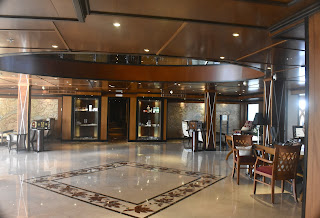

































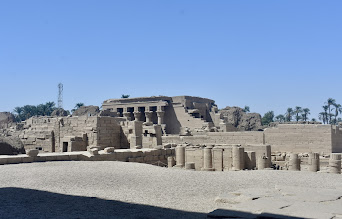


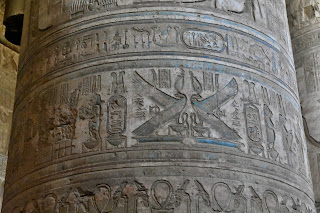









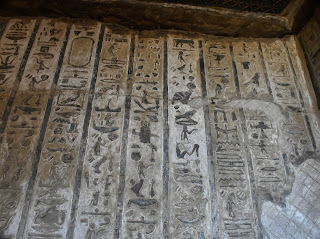


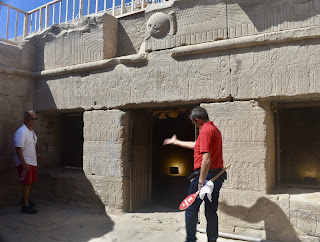












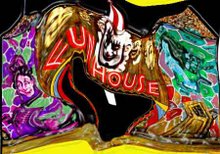

No comments:
Post a Comment